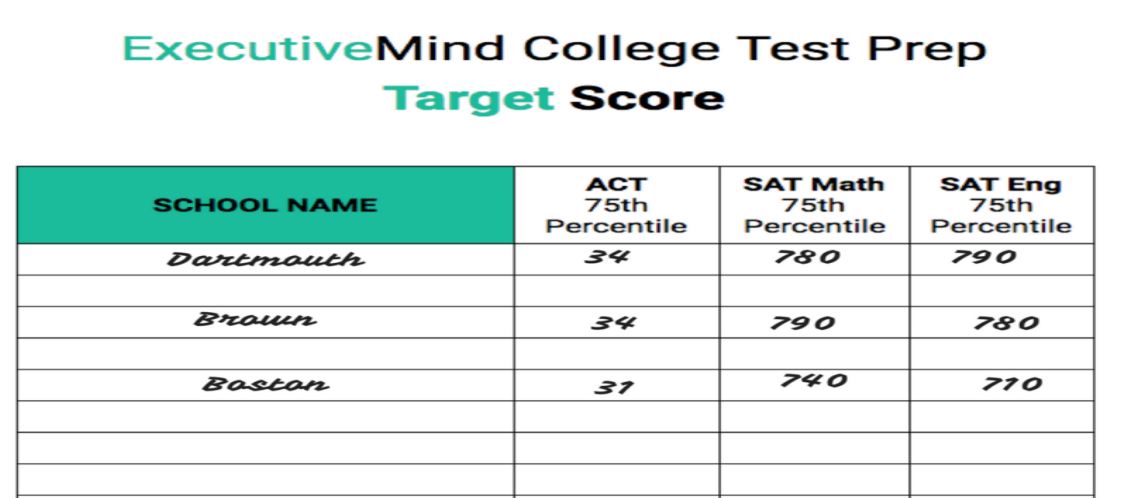But how, exactly, do you figure out whether or not your particular scores are high enough to get you into your target schools? The good news is that you don’t need to spend thousands of dollars to figure out your target score.
Once you have an accurate idea of how this all works, it’ll make your goals much clearer. Once you have a number in your mind, it’s easier to focus and make sure you are on the right track.
The 25–75 System
When you look up the average SAT® or ACT scores for any particular school, you’ll see the scores presented like this:
Columbia University:
Test Scores — 25th / 75th Percentile
- SAT® Critical Reading: 690 / 780
- SAT® Math: 700 / 790
- ACT Composite: 31 / 34
- ACT English: 32 / 35
- ACT Math: 29 / 35
What’s up with the two numbers and the slash? Shouldn’t they just show an average?
Fortunately for you, colleges DON’T release “averages” of their entering class’ SAT® and ACT scores — they publish their 25/75 range instead. Take a look at Columbia’s SAT® Critical Reading scores.
SAT® Critical Reading: 690 / 780
- Here’s what they mean:
-Only 25% of students who gain admission to Columbia score below a 690 on their critical reading section.
-Only 25% of students who gain admission to Columbia score above a 780 on their critical reading section.
-50% of students who gain admission to Columbia score between a 690 and a 780 on their critical reading section.
These numbers are incredibly helpful because they give you a range. Rather than giving you one meaningless number, they provide you with a target to shoot for.
For any school’s 25–75 range:
1. Any score BELOW the 25% range will probably keep your application from getting looked at unless you are a “special case” (recruited athlete, huge donor, sought-after minority, or any other student with an inside “liaison”).
2. Any score INSIDE the 25–75% range will get your application READ and LOOKED AT. It won’t automatically get you in, but it will let the admissions committee open your folder, learn more about you, and see whether you’re the right fit for the college.
3. Any score ABOVE the 75% range will not only get your application opened, but will actually be used as an EXTRA ADVANTAGE to pull you in. After all, if you have scores higher than the 75% range, your score will raise the school’s average entering SAT® or ACT scores, which is amazing for the school’s ranking.
As you can see, for a hyper-competitive school like Columbia, it’s extremely difficult to have score ABOVE the 75% range. When applying to an Ivy, it’s pretty tough to out-score 75% of all the admitted applicants (and there’s not much room to do it). Because getting accepted to Columbia is so hard in the first place, having 700+ scores on each section isn’t even an advantage — it’s just a requirement.
What about an equally awesome, but less competitive, school such as USC?
Test Scores — 25th / 75th Percentile
- SAT® Critical Reading: 610 / 720
- SAT® Math: 670 / 770
As you can see here, both the 25% and the 75% score ranges are significantly lower than that of Columbia.
This means that if you apply to USC with a 780 in your math and combined reading & writing+language sections, you’ll not only get your application read, but you will have a little “bonus feature” on your application that’ll increase your pull with the admissions committee.
To get your application read, you’ll need at least a 1280 — the bottom sum of the two 25% ranges. Higher would be better.
Anything between a 1280 and a 1490 will get you looked at and considered. You’ll probably have to have a slightly stronger application when you enter stage three, but you’ll still get looked at, which is what really matters. SAT® and ACT scores get you looked at. That is all. They don’t get you into a school automatically, but if your scores aren’t high enough, then the school won’t really look at your application at all.
High scores don’t get you in –they prevent you from getting rejected.
How to Set Your Target
Now that you know how colleges treat SAT® and ACT scores, it’s time to set a goal. Studying without a goal is like working a job without getting a paycheck — not very inspiring. Once you really start to imagine the colleges you’re aiming for, you’ll become more motivated and inspired, and this whole process will become much more “real” to you.
To find the 25–75 ranges for every college in the country:
1. Go to Google, type in “SAT® Scores [School X]” or “ACT Scores [School X]”.
2. Click on the 1st or 2nd result, which will always be a collegeapps.about.com link.
3. Scroll down to find the score ranges.
About.com has amazing, very up-to-date score data on every college you’ve ever heard of. This is a fantastic resource, and it makes the process very easy.
You might be surprised — some schools with “big names” have somewhat lax score requirements. Some “safety schools” require 700+ in every section. In general, considering how insanely competitive the college game is these days, expect higher score requirements no matter where you happen to be applying.
What to Do Now
Open this Google Doc and fill in your target scores for the SAT® and the ACT.
Once you’ve completed the steps above, you’ll have a good idea of exactly what scores you need to get your application reviewed. Now we enter stage two: getting your scores up to par.
If you need help getting your scores closer to the target, we can help. Let’s begin with finding out where you score right now.
Contact us to schedule a free practice test in New York.
